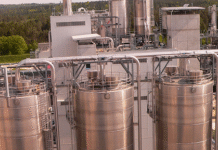Toluene is still widely used in India in the packaging print industry. As this chemical is now known to migrate from the packaging layer into the packaged goods and to potentially cause damage to organs in humans, the use of toluene has been banned in the food industries of many countries. Toluene is about to be banned in India, too, so the decision on how to substitute it in the packaging printing process will be business-critical for printers and converters.
Major ink manufacturers in India recommend Non-Toluene Non-Ketone (NTNK) as an alternative for current toluene- or MEK-based blends. For the substitution, a conventional ethanol/ethyl acetate blend (so-called ‘Ethyls’) may seem like an obvious choice. The German-based chemical company Oxea, however, points out that with a solvent system based on n-propanol and n-propyl acetate, called ‘Propyls,’ total printing cost can be significantly reduced, while being a direct replacement for Ethyls.
Potential solvent savings 30%, inks 20%
At the same time, it is claimed that with the use of Propyls, print quality is improved, and ink consumption is reduced while the printing speed can be increased. The printing process becomes more stable and less waste is generated, contributing to higher efficiency of the entire print run. Overall, industrial studies with major flexo and rotogravure printers have shown average savings potential of 30% for solvents and 20% for printing inks. Other advantages such as reduced residual solvent content, reduced ink foaming in flexographic printing and the potential to avoid retarders such as ethoxy propanol have also been demonstrated in trials at packaging printers in India.
“Especially in packaging printing, customers are demanding more sustainable printing from providers. In film printing with flexography, Propyls can be swapped directly with conventional Ethyls, with no further modifications. Printers can continue to use the same printing ink, the same equipment and the same substrate as before. With Propyls, printers use less ink and less solvent while also producing a lower percentage of scrap due to fewer machine stops. As a result, resources are conserved, and emissions of volatile organic compounds (VOCs) are reduced. Overall, productivity increases while using the same machinery as before,” said Sebastian Anton, head of Business Development from Oxea.
“Propyls have been long favored in flexography printing in North America. In recent years, Propyls became increasingly popular in Central and South America, as well as in Europe. With our new production capacity that has come on stream in 2018, now Indian printers and converters can utilize the advantages of Propyls as well,” he added.
Oxea has started to make Propyls available in India through its Indian distributor Hazel Mercantile, and provides technical support from its local offices in Mumbai. Anton will also be speaking on toluene replacement and regulations at the 8th Elite Specialty Films and Flexible Packaging Conference in Mumbai on 22 and 23 August 2019.
Technically, Propyls reduce the so-called plugging (drying out) of the cells on the printing cylinder. As a medium evaporating solvent, Propyls evaporate more slowly than Ethyls but ensure that the ink dries reliably in the process. It means that fewer refills post-dosing are required during the printing process, which leads to a significant reduction of solvent consumption and generally lower emissions of harmful substances, so-called VOCs (volatile organic compounds). In a Propyls solvent system, the pigments of the printing ink can distribute more homogeneously on the film during application due to the slightly slower drying process. This results in a higher ink density for the same amount of pigment. In this way, the printer achieves the same print quality with significantly less pigment, which saves expensive base ink. Also, improved emptying and pick-up characteristics of both the engraving cylinder and the anilox ensure optimum transfer of the printing ink onto the substrate. Thanks to the slower evaporation rate of Propyls, it is possible to increase the speed of the press in many cases without compromising print quality. Finally, Propyls demonstrate less foam formation tendency than Ethyls, especially when it comes to warm and humid ambient weather conditions.











